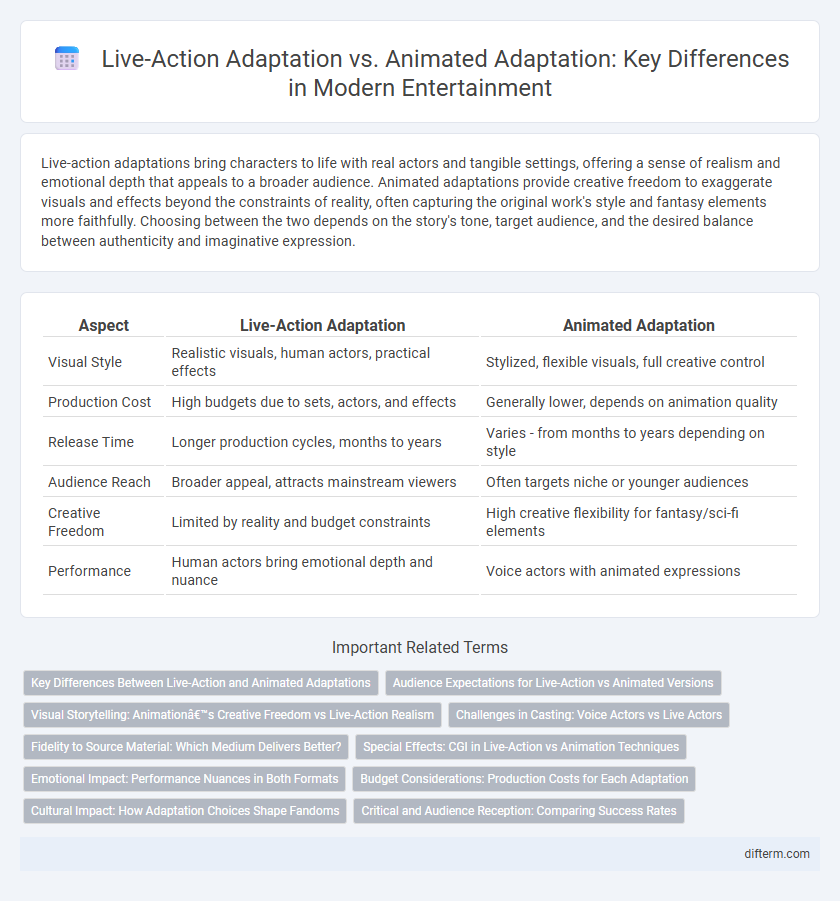Live-action adaptations bring characters to life with real actors and tangible settings, offering a sense of realism and emotional depth that appeals to a broader audience. Animated adaptations provide creative freedom to exaggerate visuals and effects beyond the constraints of reality, often capturing the original work's style and fantasy elements more faithfully. Choosing between the two depends on the story's tone, target audience, and the desired balance between authenticity and imaginative expression.
Table of Comparison
| Aspect | Live-Action Adaptation | Animated Adaptation |
|---|---|---|
| Visual Style | Realistic visuals, human actors, practical effects | Stylized, flexible visuals, full creative control |
| Production Cost | High budgets due to sets, actors, and effects | Generally lower, depends on animation quality |
| Release Time | Longer production cycles, months to years | Varies - from months to years depending on style |
| Audience Reach | Broader appeal, attracts mainstream viewers | Often targets niche or younger audiences |
| Creative Freedom | Limited by reality and budget constraints | High creative flexibility for fantasy/sci-fi elements |
| Performance | Human actors bring emotional depth and nuance | Voice actors with animated expressions |
Key Differences Between Live-Action and Animated Adaptations
Live-action adaptations feature real actors and physical settings, offering a tangible and immersive experience through authentic performances and practical effects. Animated adaptations allow for limitless creativity in visual style and character design, often enabling exaggerated actions and fantastical worlds unattainable in live-action. The production timelines and budgets also differ significantly, with live-action requiring on-location shoots and complex logistics, whereas animation demands extensive post-production and artistic input.
Audience Expectations for Live-Action vs Animated Versions
Audience expectations for live-action adaptations often emphasize realistic portrayals, detailed character development, and faithful adherence to source material to satisfy fans seeking immersive and tangible experiences. In contrast, animated adaptations attract viewers looking for stylistic creativity, exaggerated expressions, and imaginative storytelling unconstrained by physical limitations. Both formats must balance originality with respect for the original work to meet diverse fan preferences and maintain narrative integrity.
Visual Storytelling: Animation’s Creative Freedom vs Live-Action Realism
Animation offers unparalleled creative freedom in visual storytelling, enabling artists to craft fantastical worlds and exaggerated expressions that transcend real-world limitations. Live-action adaptations emphasize realism, grounding characters and settings in tangible environments and human performances that create immersive, emotionally relatable experiences. The choice between animation and live-action ultimately influences narrative style, audience engagement, and the depiction of imaginative elements within the story.
Challenges in Casting: Voice Actors vs Live Actors
Casting for live-action adaptations faces the challenge of finding actors who physically resemble beloved characters while delivering convincing emotional performances, often constrained by budget and star power. Voice actors in animated adaptations provide flexibility, allowing for diverse vocal talents unrestricted by appearance, but must convey emotion solely through voice without on-screen presence. Balancing audience expectations and character authenticity remains critical in both formats, impacting the success and reception of entertainment adaptations.
Fidelity to Source Material: Which Medium Delivers Better?
Live-action adaptations often deliver higher fidelity to source material through realistic settings and actor performances that capture nuanced character expressions and dialogue. Animated adaptations provide greater creative freedom for visualizing fantastical elements and exaggerated storytelling styles that may be limited in live-action. Ultimately, the medium's effectiveness in maintaining source fidelity depends on the narrative demands and fan expectations of franchises like "Harry Potter" or "Spider-Man: Into the Spider-Verse.
Special Effects: CGI in Live-Action vs Animation Techniques
Live-action adaptations rely heavily on advanced CGI to seamlessly blend digital effects with real actors and environments, enhancing realism and immersion. Animated adaptations utilize a variety of animation techniques such as traditional hand-drawn, 3D computer animation, and motion capture to create stylized worlds unaffected by physical constraints. The choice between CGI in live-action and animation techniques influences the creative flexibility, visual impact, and audience reception of the final production.
Emotional Impact: Performance Nuances in Both Formats
Live-action adaptations deliver emotional impact through actors' nuanced facial expressions and body language, creating a tangible connection with the audience. In contrast, animated adaptations rely on stylized visual cues, voice acting, and carefully crafted animation to express subtleties of emotion, often enhancing fantastical elements. Both formats provide unique emotional experiences, with live-action grounding authenticity and animation amplifying creative emotional expression.
Budget Considerations: Production Costs for Each Adaptation
Live-action adaptations generally require higher budgets due to expenses for sets, costumes, and actor salaries, often reaching tens of millions of dollars for major productions. Animated adaptations can be more cost-effective, with budgets focusing on animation software, voice talent, and post-production, typically ranging from a few million to around ten million dollars. Studios must weigh these production costs against potential audience reach and profitability when choosing between live-action and animated formats.
Cultural Impact: How Adaptation Choices Shape Fandoms
Live-action adaptations often generate widespread media attention, influencing popular culture through iconic performances and visually immersive experiences that attract a broader audience beyond original fans. Animated adaptations preserve stylistic authenticity and cultural nuances of the source material, fostering dedicated communities that value faithfulness and artistic expression. These adaptation choices significantly shape fandom identities, with live-action versions sparking mainstream engagement while animated adaptations maintain deep, niche cultural connections.
Critical and Audience Reception: Comparing Success Rates
Live-action adaptations often face mixed critical and audience reception due to high expectations for faithful representation and visual effects accuracy, with some successes like "The Lion King" (2019) praised for technical achievements yet critiqued for emotional depth. Animated adaptations frequently receive more favorable feedback, as seen with "Spider-Man: Into the Spider-Verse" (2018), which garnered acclaim for creative storytelling and stylistic animation, resonating with both critics and viewers. Success rates hinge on balancing authenticity and innovation, where animated adaptations excel by leveraging unique artistic freedoms that live-action versions may find limiting.
Live-action adaptation vs animated adaptation Infographic

 difterm.com
difterm.com